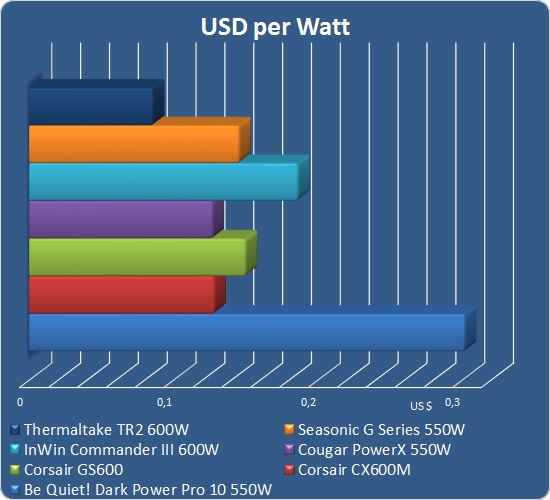7-Way 550-600 Watt Power Supply Roundup Review
Economics & Value
To rate the value of the power supplies reviewed today, we are ranking them according to their cost per watt using the market prices at the time of this review, plus their estimated annual consumption.

Using today’s market prices (product + shipping), we can see that the Dark Power Pro 10 550W unit stands quite a bit out of the crowd. As a matter of fact, it is over twice more expensive per Watt than any of the competitive units! The largest surprise however is the Seasonic G-Series 550W unit, with which the company apparently is taking a very aggressive marketing scheme, as the power supply retails for the same price as the budget-level and mainstream grade 80Plus Bronze power supplies.
The estimated annual consumption is a scenario which considers that the power supply will operate for 3000 hours per annum, 40% of the time at 25% load, 50% at 50% load and 10% at 80% load. Due to the fact that the cost of energy varies greatly per region, we present our results directly in kWh per rated W, which can then easily be converted to money by multiplying the number with the cost per kWh denoted on your current energy bill and the power supply’s maximum output. For example, today’s kWh cost in the Los Angeles area is 0.216 USD/kWh, so if a 600W power supply ends up using 1.4 kWh/Wr/annum, then the annual running cost is 0.216 * 1.4 * 600 = 181.44 USD.

It is obvious that the more efficient units will perform much better in this test. The 80Plus Gold certified units achieve figures as low as 1.43 kWh/Wr/Annum, while the 80Plus Bronze units can reach up to 1.53 kWh/Wr/Annum. Corsair’s units land in between, with an estimated consumption of 1.493 kWh/Wr/Annum.
The monetary difference is small but significant and can easily turn the tables of value around. For example, considering that the energy cost is 0.128 USD/kWh (US current average), the Seasonic G-Series 550W unit will consume 101 USD per annum, while the Cougar PowerX 550W unit will consume 108 USD per annum, negating the price difference between the two units within one year. Of course, even as the difference increases along with the cost of energy, that alone will not be enough to justify a large difference on the retail price of any power supply.

Comments are closed.